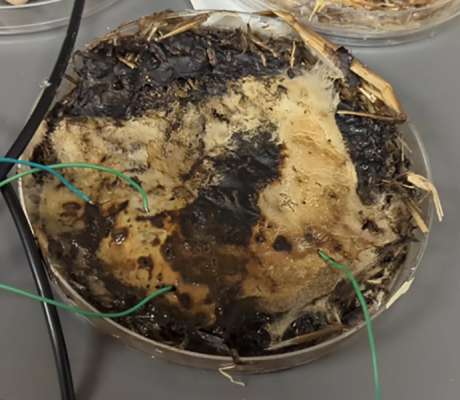Fungal networks may be a promising alternative to tiny metal devices used in processing and storing digital memories and other computer data, according to a new study.
Mushrooms have long been recognized for their extreme resilience and unique properties. Their innate abilities make them perfect specimens for bioelectronics, an emerging field that, for next-gen computing, could help develop exciting new materials.
As one example, researchers from The Ohio State University recently discovered that common edible fungi, such as shiitake mushrooms, can be grown and trained to act as organic memristors, a type of data processor that can remember past electrical states.
 Their findings showed that these shiitake-based devices not only demonstrated similar reproducible memory effects to semiconductor-based chips but could also be used to create other types of low-cost, environmentally friendly, brain-inspired computing components.
Their findings showed that these shiitake-based devices not only demonstrated similar reproducible memory effects to semiconductor-based chips but could also be used to create other types of low-cost, environmentally friendly, brain-inspired computing components.
"Being able to develop microchips that mimic actual neural activity means you don't need a lot of power for standby or when the machine isn't being used," said John LaRocco, lead author of the study and a research scientist in psychiatry at Ohio State's College of Medicine. "That's something that can be a huge potential computational and economic advantage."
Fungal electronics aren't a new concept, but they have become ideal candidates for developing sustainable computing systems, said LaRocco. This is because they minimize electrical waste by being biodegradable and cheaper to fabricate than conventional memristors and semiconductors, which often require costly rare-earth minerals and high amounts of energy from data centers.
"Mycelium as a computing substrate has been explored before in less intuitive setups, but our work tries to push one of these memristive systems to its limits," he said.
The study was recently published in the journal PLOS ONE.
 To explore the new memristors' capabilities, researchers cultured samples of shiitake and button mushrooms. Once mature, they were dehydrated to ensure long-term viability, connected to special electronic circuits, and then electrocuted at various voltages and frequencies.
To explore the new memristors' capabilities, researchers cultured samples of shiitake and button mushrooms. Once mature, they were dehydrated to ensure long-term viability, connected to special electronic circuits, and then electrocuted at various voltages and frequencies.
"We would connect electrical wires and probes at different points on the mushrooms because distinct parts of it have different electrical properties," said LaRocco. "Depending on the voltage and connectivity, we were seeing different performances."
After two months, the team discovered that when used as RAM - the computer memory that stores data - their mushroom memristor was able to switch between electrical states at up to 5,850 signals per second, with about 90% accuracy. However, performance dropped as the frequency of the electrical voltages increased, but much like an actual brain, it could be fixed by connecting more mushrooms to the circuit.
Overall, their research details how surprisingly easy it is to program and preserve mushrooms to behave in unexpected and useful ways, said Qudsia Tahmina, co-author of the study and an associate professor in electrical and computer engineering at Ohio State. Moreover, it's an example of how technology can advance when it relies on the natural world.

"Society has become increasingly aware of the need to protect our environment and ensure that we preserve it for future generations," said Tahmina. "So that could be one of the driving factors behind new bio-friendly ideas like these."
Building on the flexibility mushrooms offer also suggests there are possibilities for scaling up fungal computing, said Tahmina. For instance, larger mushroom systems may be useful in edge computing and aerospace exploration; smaller ones in enhancing the performance of autonomous systems and wearable devices.
Organic memristors are still in early development, but future work could optimize the production process by improving cultivation techniques and miniaturizing the devices, as viable fungal memristors would need to be far smaller than what researchers achieved in this work.
"Everything you'd need to start exploring fungi and computing could be as small as a compost heap and some homemade electronics, or as big as a culturing factory with pre-made templates," said LaRocco. "All of them are viable with the resources we have in front of us now."
Other Ohio State co-authors include Ruben Petreaca, John Simonis and Justin Hill. This study was supported by the Honda Research Institute.






